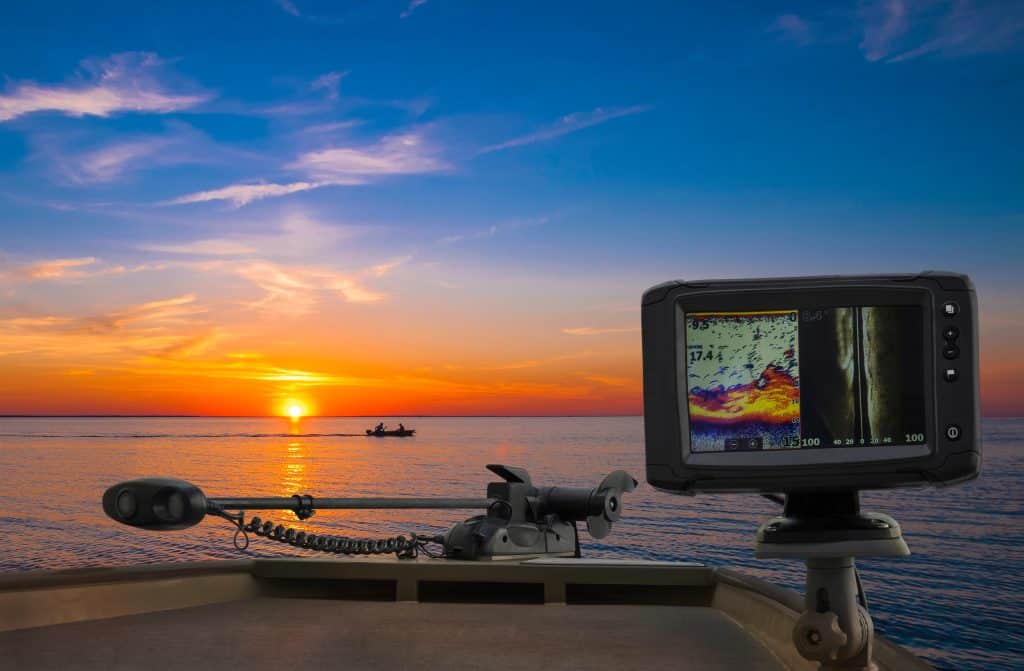Unveiling the First Challenge: Finding the Fish
Exploring the rich traditions of angling, which span thousands of years and are built upon intuition and skill, raises the question of why one should embrace fishing sonar technology. The answer lies in its undeniable advantage, particularly when navigating unfamiliar waters. While it doesn’t possess the magical ability to make fish bite, fishing sonar excels at resolving the initial and crucial challenge in fishing: locating the fish.
Sonar, short for Sound Navigation and Ranging, can be categorized into two primary types: active and passive. In the realm of angling, it’s active sonar that takes center stage. Fishing sonar functions by emitting sound pulses into the water and listening for echoes, somewhat akin to the echolocation used by certain animals. This technology has emerged as an invaluable tool for pinpointing the presence of fish beneath the water’s surface.
To truly appreciate the significance of sonar technology in the context of fishing, it’s essential to understand its role. Fishing inherently presents two fundamental challenges: finding the fish and enticing them to bite. While sonar doesn’t directly influence the latter, it plays a pivotal role in addressing it. Your chances of achieving a successful catch are considerably diminished without accurate knowledge of where the fish are located.
Diving into Depths: Down Scan and Side Scan Fishing Sonar
Fish finders, a specialized type of sonar tailored for anglers, are designed to pinpoint fish by detecting air in their swim bladders. This air causes the sound to refract, creating a distinctive echo pattern. Fish finders then translate these echoes into visual images on a screen. Fish finders provide detailed information by employing high-frequency sound waves, usually ranging from 20 to 200 kHz, often displaying fish as distinct marks on the net. Lower frequency sonar systems may offer greater depth penetration but might struggle to reveal individual objects.
Two general variations prevail in fishing sonar: down scan and side scan. Down check sonar; the more familiar the two display marks or fish as your boat passes over them. However, it cannot indicate whether the fish are to your left or right. This limitation is where side scan sonar comes into play, offering a more comprehensive view from side to side. While it provides less detail, it helps you understand the horizontal positioning of fish.
Dive Deeper with Downrods
Downrods play a pivotal role in enhancing the effectiveness of sonar technology in angling. These specialized tools lower the sonar transducer to greater depths beneath the water’s surface. One of the primary advantages of using downrods is extending the sonar beam’s reach, allowing it to penetrate deeper into the water column. This extended depth capability is crucial, especially when trying to locate fish that may be dwelling at lower levels. By positioning the transducer deeper with a downrod, anglers gain access to a more comprehensive view of the underwater terrain, which is essential for accurately pinpointing fish and understanding their behavior.
Furthermore, downrods enable anglers to maintain optimal positioning of the sonar transducer, ensuring it remains submerged at the desired depth. This stability is critical for obtaining consistent and reliable sonar readings, as it prevents the transducer from fluctuating with the water’s surface or the boat’s movement. In turbulent conditions or when navigating varying depths, downrods help maintain a steady sonar signal, enhancing the overall performance of the sonar system.
Moreover, downrods are versatile accessories that can be adjusted to accommodate different fishing conditions and target species. Whether fishing in deep freshwater lakes, coastal areas, or offshore environments, downrods can be customized to reach the appropriate depths and provide accurate sonar data. In summary, downrods are essential tools that expand the capabilities of sonar technology, allowing anglers to explore greater depths and improve their chances of successfully locating and catching fish.
Deciphering the Marks: Identifying Fish Species
- Shorter, Comprehensive Marks: When you come across more straightforward, more comprehensive marks on the sonar screen, these often suggest the presence of slower-moving fish species, such as carp and drum. These fish create distinct, solid spots due to their deliberate movements along the bottom.
- Dotted Lines: On the other hand, dotted lines on the sonar screen may imply the presence of faster species like stripers. These fish exhibit rapid, darting movements, resulting in a spotted appearance on the display. Anglers often associate these patterns with more active and predatory fish.
- Baitfish Clusters: smaller fish species often targeted by larger predators tend to move in large groups. This behavior results in clusters of tiny dots on the sonar screen. Recognizing these baitfish schools can be crucial, as they can attract larger gamefish searching for a meal.
Size Matters: Insights from Fishing Sonar Scaling
Accurately estimating the size of underwater objects, mainly fish, is valuable for any angler looking to enhance their success on the water. While sonar systems provide essential size-related information on their screens, several factors can influence these estimations. Understanding the nuances of size perception about depth variation, water clarity, and screen resolution and employing comparative analysis can significantly improve your ability to assess the dimensions of fish and other objects detected by your sonar. This guide will explore these factors and how they can empower you to make informed decisions while pursuing your angling endeavors.
- Depth Variation: When interpreting size-related information on your sonar screen, consider the depth at which objects appear. Different depths can distort the perceived size of things. For example, a fish closer to the surface may appear more prominent on the screen than a fish at greater depths due to the angle of the sonar beam.
- Water Clarity: Water clarity can also influence size estimation. Objects in murky or turbid waters may appear larger or fuzzier on the sonar screen than in clear waters. Understanding how water conditions affect size perception can help you make more accurate assessments.
- Screen Resolution: The resolution of your sonar screen can impact your ability to estimate size accurately. Higher-resolution screens provide finer details, making distinguishing between objects of varying sizes easier. Investing in a better-resolution sonar unit can enhance your size estimation capabilities.
- Comparative Analysis: To refine your size estimation skills, compare the sizes of known objects or fish species with those displayed on the sonar screen. Over time, this comparative analysis will help you develop a better sense of scale and improve your accuracy in assessing the size of underwater elements.
By considering these factors and continually honing your skills through practice and observation, you’ll become more adept at accurately estimating the size of fish and other objects detected by your sonar system. This proficiency will contribute to your overall success as an angler, allowing you to make informed decisions while on the water.
Consistency, Depth, and Structures: Keys to Fishing Sonar Success
Consistency in using a sonar unit is not just about settings; it extends to your fishing strategy. It involves having a systematic method for interpreting sonar data and integrating it into your angling tactics. This consistency lets you make informed decisions quickly and efficiently while on the water.
Monitoring changes in water depth is crucial because it can directly affect fish behavior. Fish often relate to specific depth ranges based on temperature, oxygen levels, and food availability. By staying attuned to depth changes detected on your sonar, you can adjust your fishing techniques to target fish in their preferred zones.
Understanding the impact of underwater structures is a crucial aspect of successful angling. Fish use these structures for shelter, foraging, and as ambush points. They are identifying these underwater features, whether submerged brush piles, rock formations, or drop-offs, providing valuable insights into where fish will likely congregate. It allows you to strategically position your bait or lures to increase your chances of a successful catch.
Incorporating these elements into your fishing routine and sonar expertise will significantly enhance your angling skills and increase your chances of success on the water. Remember that fishing is not just about technology but also about experience, observation, and adapting to the conditions you encounter.
Making Fishing Sonar Work for You
In conclusion, sonar technology has emerged as an invaluable tool for anglers, offering a significant advantage when finding fish beneath the water’s surface. While it doesn’t guarantee that fish will bite, it excels at addressing the critical first challenge in fishing: locating the fish.
In the angling world, where tradition meets technology, sonar has proven to be a valuable ally. Embrace its power, practice with patience, and enjoy the journey of becoming a more skilled and successful angler. Remember that fishing is not just about the catch; it’s about the experience and the continuous quest to unlock the secrets of the underwater world.

